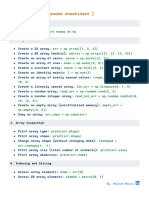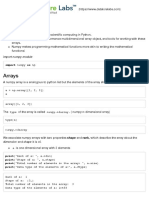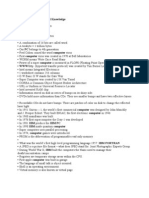Numpy
1. Introduction to NumPy
NumPy (Numerical Python) is a powerful library for numerical computations in
Python.
It provides support for large multi-dimensional arrays and matrices, along with
a collection of mathematical functions to operate on these arrays.
2. Installation
bash
Copy code
pip install numpy
Import NumPy in your script:
python
Copy code
import numpy as np
3. Creating Arrays
From Lists:
python
Copy code
arr = np.array([1, 2, 3])
arr_2d = np.array([[1, 2, 3], [4, 5, 6]])
Using Functions:
Numpy 1
� python
Copy code
zeros = np.zeros((2, 3)) # 2x3 array of zeros
ones = np.ones((2, 3)) # 2x3 array of ones
empty = np.empty((2, 3)) # 2x3 uninitialized arr
ay
arange = np.arange(0, 10, 2) # Array of [0, 2, 4, 6,
8]
linspace = np.linspace(0, 1, 5) # 5 evenly spaced numbe
rs between 0 and 1
4. Array Attributes
Dimensions:
python
Copy code
arr.ndim # Number of dimensions
Shape and Size:
python
Copy code
arr.shape # Shape of the array
arr.size # Total number of elements
Data Type:
python
Copy code
Numpy 2
� arr.dtype # Data type of elements
5. Reshaping Arrays
python
Copy code
arr = np.arange(1, 7) # [1 2 3 4 5 6]
reshaped = arr.reshape((2, 3)) # [[1 2 3], [4 5 6]]
6. Indexing and Slicing
1D Arrays:
python
Copy code
arr[0] # First element
arr[-1] # Last element
2D Arrays:
python
Copy code
arr_2d[0, 1] # Element in first row, second column
arr_2d[:, 1] # All rows, second column
arr_2d[1, :] # Second row, all columns
Slicing:
python
Copy code
arr[1:4] # Elements from index 1 to 3
Numpy 3
� arr[::2] # Every other element
7. Array Operations
Element-wise Operations:
python
Copy code
arr1 = np.array([1, 2, 3])
arr2 = np.array([4, 5, 6])
sum = arr1 + arr2 # [5, 7, 9]
product = arr1 * arr2 # [4, 10, 18]
scalar_mult = arr1 * 2 # [2, 4, 6]
Mathematical Functions:
python
Copy code
np.sqrt(arr1) # Square root
np.exp(arr1) # Exponential
np.sin(arr1) # Sine
8. Linear Algebra
python
Copy code
mat1 = np.array([[1, 2], [3, 4]])
mat2 = np.array([[5, 6], [7, 8]])
dot_product = np.dot(mat1, mat2) # Matrix multiplication
transpose = mat1.T # Transpose of the matri
Numpy 4
� x
Inverse and Determinant:
python
Copy code
inv_mat = np.linalg.inv(mat1)
det_mat = np.linalg.det(mat1)
9. Broadcasting
Broadcasting allows arithmetic operations on arrays of different shapes.
python
Copy code
arr = np.array([1, 2, 3])
add_scalar = arr + 2 # [3, 4, 5]
add_array = arr + np.array([1]) # [2, 3, 4]
10. Aggregations
Basic Statistical Operations:
python
Copy code
arr = np.array([1, 2, 3, 4, 5])
arr.sum() # Sum of all elements
arr.mean() # Mean value
arr.std() # Standard deviation
arr.min() # Minimum value
arr.max() # Maximum value
Numpy 5
� Axis-wise Operations:
python
Copy code
arr_2d = np.array([[1, 2], [3, 4]])
arr_2d.sum(axis=0) # Sum of each column [4, 6]
arr_2d.sum(axis=1) # Sum of each row [3, 7]
11. Random Number Generation
python
Copy code
rand_arr = np.random.rand(3, 2) # 3x2 array with rand
om numbers between 0 and 1
rand_int = np.random.randint(0, 10, 5) # Array of 5 random i
ntegers between 0 and 9
12. Advanced Indexing
Boolean Indexing:
python
Copy code
arr = np.array([1, 2, 3, 4, 5])
bool_idx = arr > 3 # [False, False, Fals
e, True, True]
filtered_arr = arr[bool_idx] # [4, 5]
Fancy Indexing:
python
Copy code
Numpy 6
� arr = np.array([10, 20, 30, 40, 50])
indices = [1, 3]
arr[indices] # [20, 40]
13. Copying Arrays
View (Shallow Copy):
python
Copy code
arr = np.array([1, 2, 3])
view = arr.view()
view[0] = 7
print(arr) # [7, 2, 3]
Copy (Deep Copy):
python
Copy code
copy = arr.copy()
copy[0] = 1
print(arr) # [7, 2, 3]
14. File I/O with NumPy
Saving and Loading Arrays:
python
Copy code
np.save('array.npy', arr)
loaded_arr = np.load('array.npy')
Numpy 7
� Text Files:
python
Copy code
np.savetxt('array.txt', arr, delimiter=',')
loaded_txt_arr = np.loadtxt('array.txt', delimiter=',')
15. Performance Tips
Use NumPy's built-in functions which are implemented in C and optimized for
performance.
Avoid loops; use vectorized operations instead.
Use .astype to convert data types if you need to optimize memory usage.
16. Common Pitfalls
Be aware of the differences between views and copies.
When performing operations that modify the original array, ensure that’s your
intention, as some methods act in-place.
17. Practical Examples
Element-wise Operations:
python
Copy code
data = np.array([1.0, 2.0, 3.0])
adjusted_data = data * 2.5 + 3
Normalizing Data:
python
Copy code
data = np.array([5, 10, 15])
Numpy 8
� normalized = (data - data.min()) / (data.max() - data.min
())
Finding Unique Elements:
python
Copy code
arr = np.array([1, 2, 2, 3, 4, 4, 4])
unique_elements = np.unique(arr)
18. Further Learning
NumPy Documentation: The official documentation is a great resource for
understanding all the functions and features of NumPy.
Practice Problems: Try implementing various mathematical and statistical
operations using NumPy to build your understanding.
Numpy 9





















































































